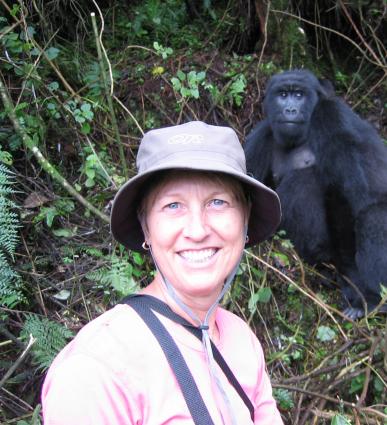Guardian of giants: Lab volunteer watches over the welfare of rescued exotic animals
 (Download Image)
Lawrence Livermore Industrial Hygiene Group Leader Diana Larson volunteers for PAWS' “Elephant Grape Stomp, An Afternoon In TUSKany” event.
(Download Image)
Lawrence Livermore Industrial Hygiene Group Leader Diana Larson volunteers for PAWS' “Elephant Grape Stomp, An Afternoon In TUSKany” event.
Editor's Note: During the Helping Others More Effectively (HOME) Campaign, Public Affairs will run a series of articles about Lawrence Livermore National Laboratory employees who volunteer for various nonprofit agencies.
It is the middle of the night in San Andreas, two hours northeast of Livermore, where a barn of sleeping African and Asian elephants make a rumbling sound akin to purring.
That is where you could find Diana Larson wide awake, keeping watch over the elephants and logging their behaviors during the night. The aging animals have health problems, especially with their feet, so someone needs to be alert for signs of distress and call for help if there is a medical problem. She may toss the elephants some hay if they look hungry; otherwise she keeps her distance and lets them relax. The barn sits atop 2,300 acres of rolling hills at one of three sites the Performing Animal Welfare Society (PAWS) calls home.
Elephants are not the only creatures roaming the grounds. They have bears, tigers, lions, black leopards and primates among other exotic animals.
"We get them from circuses, zoos, abused environments and neglected environments," said Larson, Lawrence Livermore National Laboratory's industrial hygiene group leader. "This is a retirement home for them; they get to live out their lives pretty quietly. The only time people from the outside are invited to see the animals is during our open houses that only happen a few times a year. Most of their stories, if you listen to them, are heartbreaking."
PAWS began in 1984 by former Hollywood animal trainer Pat Derby, who worked on the sets of television shows such as "Flipper" and "Lassie." The cruel training tactics used in the entertainment industry shocked her. Derby’s advocacy grew over the next 30 years, creating sanctuaries, education and legislative change to improve the lives of animals.
Larson began volunteering with PAWS 15 years ago doing everything from helping in the gift shop to poison oak abatement and fence inspections. Today, she helps give tours as a docent during open houses and other events.
The group’s work with lawmakers resonates with her most because it means long-lasting changes across the state. PAWS worked to sponsor and support laws in California banning the use of bull hooks (a cruel sharp hook attached to a rod) used to control and punish elephants, and outlawing canned hunts, the shooting of wild animals kept in enclosures. Although PAWS has been successful to improve the lives of captive animals, more work needs to be done.
Larson has traveled to Africa with the Oakland Zoo to support and visit conservation projects the zoo supports. Visiting Uganda and Rwanda gave her the chance to observe many of the species she has worked with in their natural habitat. "It was surreal. It was amazing to see elephants in the wild just grazing and drinking water," Larson said. The trip gave her an even deeper appreciation for the animals, and she plans to visit Kenya with the Oakland Zoo in January.
"Of our dedicated PAWS volunteers, Diana truly represents the best of the good folks who were called upon to help our captive wildlife sanctuary," said Kim Gardner, director of programs at PAWS. "Diana came to stay and work hard and make a difference. She continues to prove herself as one of our most trusted and committed volunteers."
Larson always will carry the stories of the animals she’s encountered at the sanctuary, which show the difference PAWS can make in the lives of these animals. She remembers the time when two Asian elephants, Wanda and Gypsie, were first introduced. They ran toward each other squealing and intertwining their trunks, a very unusual behavior for elephants who have never met. After some research, PAWS found the two had been in the circus together 20 years prior. "It’s true that elephants never forget," Larson said. And these two elephants remained inseparable, the best of friends.
"As good as a life that PAWS provides, they are still captive animals. I’d love to see a time when there’s no need for animal sanctuaries. That these animals would be roaming in the wild. I don’t know if that will ever happen, but that’s the goal."
Contact
Kate Hunts[email protected]
925-422-1322
Related Links
Performing Animal Welfare SocietyTags
Community OutreachFeatured Articles








